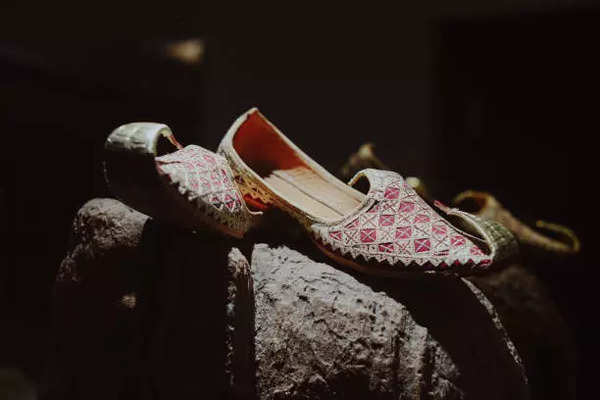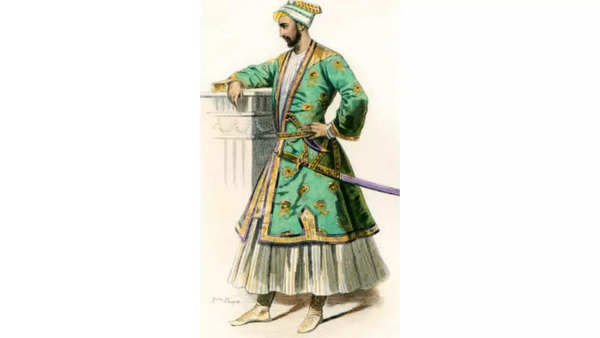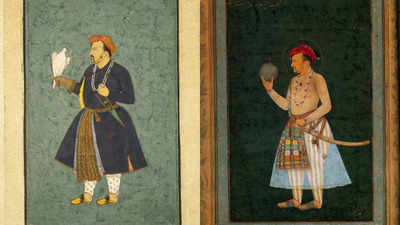Akbar to Jahangir: How Mughal emperors used royal footwear to flaunt their power

In the opulent courts of the Mughal Empire, grandeur wasn’t just worn on the sleeves, it started from the feet. While the Mughal emperors and nobles are often remembered for their lavish robes, jewelled turbans, and intricate jewellery, a lesser-known but equally significant symbol of status was their footwear. Whether it was Akbar, Shah Jahan, or Jahangir, the shoes worn by members of the court were as telling of one’s social standing as any title or landholding. The Mughal foot, quite literally, stepped into luxury, with different styles and materials marking out the hierarchy of the empire.
Footwear as a symbol of hierarchy
The Mughal Empire, known for its rigid administrative structure and deeply embedded class system, reflected this hierarchy in its dress codes. Clothing, and particularly footwear, was not just about fashion, it was about one’s place in the imperial cosmos. Specific styles of shoes were often reserved for certain ranks, and deviations could be seen as disrespect or insubordination.

The royal wardrobe had guidelines, and footwear, being visible and symbolic, was used to differentiate nobles from commoners, warriors from scholars, and emperors from even the highest-ranking officials. From the intricacy of embroidery to the curve of the toe, every element of a Mughal shoe was encoded with meaning.
The Kafsh: For the noblest feet
Among the finest of Mughal footwear was the Kafsh, typically worn by nobles and kings. The Kafsh was a closed shoe, often made of high-quality leather, and richly ornamented with zari (gold or silver thread), velvet lining, and sometimes even precious stones. The shoe’s robust design reflected both authority and opulence. Reserved for the elite, it was not just a piece of attire but a declaration of proximity to power. Wearing the Kafsh signalled access to the emperor and influence within the court.
The Charhvan: Military might meets aesthetic grace
Another distinctive style was the Charhvan, known for its curling toe—an iconic silhouette that continues to be echoed in Indian juttis today. With a pointed, upward curling front fixed to the toe, the Charhvan was often associated with military commanders and men of high rank. While it carried a more masculine and martial air, it was still crafted with luxury, embroidered with metallic threads or adorned with decorative elements. These were not shoes for battle, but ceremonial attire, meant to reflect the bearer’s status within the Mughal military order.
The Salim Shahi: Royal elegance in every step
Named after Emperor Salim, better known as Jahangir, the Salim Shahi became synonymous with princely elegance. These were typically decorated in gold, with soft leather interiors and ornate uppers. They were lighter than the Kafsh but still exuded regality. Favoured by young princes and royal courtiers, the Salim Shahi was more than footwear, it was an expression of refinement and taste. The golden finish often hinted at the wearer’s closeness to the imperial family or their role in courtly rituals.
The Khurd Nau: Lightweight, practical, yet precious
For those who sought both comfort and status, the Khurd Nau was an ideal choice. Crafted from kid leather, it was extremely lightweight, allowing ease of movement, especially in the sweltering Indian summers. Despite its practical design, it was far from plain. These shoes were often dyed in vibrant colours, and their craftsmanship indicated that they were made for someone of importance, albeit perhaps of a scholarly or administrative nature rather than martial or royal.

The Khurd Nau was especially popular among high-ranking officials, poets, and artists within the Mughal court. It reflected a refined aesthetic, suited for those whose status came not from birthright or war, but from intellect and patronage.
Footwear and sumptuary laws
Much like European sumptuary laws that dictated who could wear what fabrics or colours, the Mughal court had unwritten codes that regulated footwear. While not formalised in strict legal terms, there were cultural expectations around who could wear what kind of shoe. A commoner attempting to wear a style reserved for the court could face ridicule or even punishment, as clothing was part of maintaining the social order.
Even within the harem, the women’s shoes varied by rank. Princesses and queens wore elaborately beaded or embroidered slippers with curled toes and soft padding, while attendants wore simpler designs.
Emperors and their footwear preferences
Each Mughal emperor had his own preferences that influenced footwear trends across the court. Akbar, for instance, had a keen eye for blending regional styles, and his patronage led to a fusion of Persian and Indian design in courtly shoes. Jahangir, known for his love of art and aesthetics, encouraged innovation in patterns and materials. Under Shah Jahan, with the construction of the Taj Mahal and an emphasis on architectural symmetry, even shoes began reflecting more structured and elegant patterns.
Interestingly, it was also under Akbar’s rule that footwear became more inclusive of Indian traditions, moving away from purely Persian designs. This inclusivity reflected his broader policy of Sulh-e-Kul, or universal tolerance, which sought to unify the diverse empire under a single cultural umbrella, down to the shoes on his courtiers’ feet.
The legacy today
Though the Mughal Empire has long passed into history, its influence on fashion and particularly footwear remains. The jutti, mojari, and various forms of ethnic Indian shoes worn today are direct descendants of Mughal styles. Designers like Sabyasachi and Abu Jani Sandeep Khosla often look to Mughal footwear for inspiration, reviving traditional techniques and silhouettes in their couture lines.
What once demarcated class and power now represents heritage and craftsmanship. But whether worn in a royal court or a modern-day wedding, Mughal-inspired shoes still whisper tales of hierarchy, elegance, and the politics of fashion, one step at a time.
















